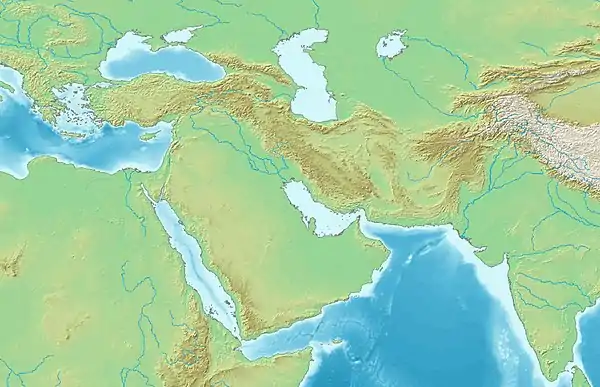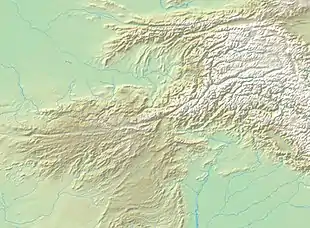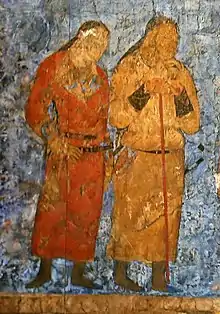Ikhshids of Sogdia Unash | |||||||||||||
|---|---|---|---|---|---|---|---|---|---|---|---|---|---|
| 642–755 CE | |||||||||||||
 IKHSHIDS Location of Samarkand, capital of the Ikhshids, and neighbouring polities. | |||||||||||||
 IKHSHIDS The Ikhshids, and proximate polities and cities. | |||||||||||||
| Capital | Samarkand | ||||||||||||
| Common languages | Sogdian | ||||||||||||
| Religion | Zoroastrianism | ||||||||||||
| Historical era | Late antiquity | ||||||||||||
• Established | 642 | ||||||||||||
• Disestablished | 755 CE | ||||||||||||
| |||||||||||||
The Ikhshids of Sogdia, or Ikhshids of Samarkand, were a series of rulers of Soghdia in Transoxiana, with their capital at Samarkand, during the pre-Islamic and early Islamic periods.[3]
The princely title "Ikhshid" (from Sogdian: xšyδ, xšēδ "Ruler") is of Iranian origin; scholars have derived it variously from the Old Iranian root khshaeta, "shining, brilliant", or from khshāyathiya, "ruler, king" (which is also the origin of the title shah).[3] The Ikhshids of Soghdia, with their capital at Samarkand, are well attested during and after the Muslim conquest of Transoxiana. The rulers of the Principality of Farghana were also called "Ikhshids".
Ikhshids dynasty of Sogdia
Shishpir, originally ruler of Kish, conquered Samarkand in 631-642 CE and founded the Ikhshid dynasty.[4] His rule in Samarkand followed that of the Hunnic tribes who had taken control of the city since around 437 CE. The founder Shishpir was succeeded by several generations of kings, who are recorded in Chinese chronicles and known through their coinage.[4]
The Hunnic legacy appears in the coinage of Shishpir, as he adopted the Hunnic Y-shaped tamgha (![]() ) on the reverse of his coins.[4] The symbol of the Hephthalites thus appears on the residual coinage of Samarkand, probably as a consequence of the Hephthalite control of Sogdia, and becomes prominent in Sogdian coinage until the Muslim conquest of Transoxiana.[5]
) on the reverse of his coins.[4] The symbol of the Hephthalites thus appears on the residual coinage of Samarkand, probably as a consequence of the Hephthalite control of Sogdia, and becomes prominent in Sogdian coinage until the Muslim conquest of Transoxiana.[5]
Inscriptions found in the ruins of the Ikhshid palace at Samarkand and the legends of coins suggest that the Ikhsids called their own dynasty "Unash", i.e. "Hunnish".[6] The paintings of the Afrasiab murals, made in the early Ikhshid period, contain an inscription mentioning King "Varkhuman Unash"
Afrasiab Sogdian inscriptionWhen King Varkhuman Unash came to him [the ambassador] opened his mouth [and said thus]: "I am Pukarzate, the dapirpat (chancellor) of Chaganian. I arrived here from Turantash, the lord of Chaganian, to Samarkand, to the king, and with respect [to] the king [now] I am [here]. And with regard to me do not have any misgivings: About the gods of Samarkand, as well as about the writing of Samarkand I am keenly aware, and I also have not done any harm to the king. Let you be quite fortunate!" And King Varkhuman Unash took leave [of him]. And [then] the dapirpat (chancellor) of Chach opened his mouth.
Afrasiab murals
The paintings of Afrasiab in Samarkand date back to the middle of the 7th century CE at the early stage of the Ilkhshid period, showing a reception of foreign dignitaries by Ikhshid king Varkhuman. They were probably painted circa 655 CE, as the Western Turkic Khaganate, members of which appear abundantly in the mural, was in its last days before its fall in 657 CE, and the Tang dynasty was increasing its territory in Central Asia.[8][9][10] On the four walls of the room of a private house, three or four countries in neighbouring Central Asia are depicted. On the northern wall China (a Chinese festival, with the Empress on a boat, and the Emperor hunting), on the Southern Wall Samarkand (i.e.; the Iranian world: a religious funerary procession in honor of the ancestors during the Nowruz festival), on the eastern wall India (as the land of the astrologers and of the pygmies, but the painting is much destroyed there).
 Western Turk officers escorting dignitaries visiting king Varkhuman in Samarkand. One of them is labeled as coming from Argi (Karashahr in modern Xinjiang). Afrasiab mural, probably painted circa 655 CE.[11][12]
Western Turk officers escorting dignitaries visiting king Varkhuman in Samarkand. One of them is labeled as coming from Argi (Karashahr in modern Xinjiang). Afrasiab mural, probably painted circa 655 CE.[11][12]%252C_and_Chach_(modern_Tashkent)_to_king_Varkhuman_of_Samarkand._648-651_CE%252C_Afrasiyab_Museum%252C_Samarkand%252C_Uzbekistan.jpg.webp)

 Tang dynasty emissaries at the court of Varkhuman in Samarkand carrying silk and a string of silkworm cocoons, circa 655 CE, Afrasiyab murals, Samarkand
Tang dynasty emissaries at the court of Varkhuman in Samarkand carrying silk and a string of silkworm cocoons, circa 655 CE, Afrasiyab murals, Samarkand
Chinese protectorate (from 658)
The Ikhshids became nominal vassals of the Chinese Tang dynasty. The Chinese asserted their political power in Central Asia at the expense of the Western Turks, through the establishment of the Anxi Protectorate and the formal appointment of local rulers to Governor positions in the provinces established by the Chinese.[18] As soon as 650-655 CE, Varkhuman was recognized by the Chinese as "King of Kangju" (Sogdia), and Governor, as reported by Chinese chronicles:[11][19]
During the Yonghui (永徽) era (650-655 CE), emperor Gaozong made this territory the Government of Kangju, and gave the title of Governor to the King of the country, Varkhuman (拂呼缦, Fúhūmàn).
The Western Turks, who had been the main power for about a century in the region, disintegrated following the Tang Conquest of the Western Turks and the demise of their ruler Ashina Helu in 658 CE, becoming vassals of the Chinese thereafter.[18][21] The Tang dynasty would establish more or less nominal Protectorates and military garrisons throughout the area, but this control only lasted for a few years.[16] By 662 rebellions broke out throughout the area, and the Western Turks were able to reestablish preeminence, with the Tangs only retaining sporadic and indirect control.[16]
During this period, the Ikhshids and other Central Asian polities repeatedly requested Chinese military aid, especially against Muslim conquests, but these requests were generally met with empty promises, as the Chinese army, led by general Gao Xianzhi, was busy with the war against Tibet.[22]
Epilogue
The line survived into Abbasid times, although by then its seat was in Istikhan.[3]
Ghurak
Among the most notable and energetic of the Soghdian kings was Ghurak, who in 710 overthrew his predecessor Tarkhun and for almost thirty years, through shifting alliances, managed to preserve a precarious autonomy between the expanding Umayyad Caliphate and the Türgesh khaganate.[23]
In 718, Ghurak is known to have sent an embassy to the China court, asking for support against the Arabs, but military help was denied, probably because of the huge cost and distances involved:[24][25]
"Then King Ghurak couldn't win in war against the Arabs. He came to plead for help, but the Emperor refused."
In retaliation, the Arab governor may have appointed Divashtich, the ruler of nearby Panjikent, as ruler of Samarkand in order to replace Ghurak.[24] Some of the coinage of Samarkand may have been issued by Divashtich, and may correspond to this period.[24] The power of the Arabs in the region continued to increase, as they defeated the rebellion of Divastich in 722 CE.[18]
Turgar
The reign of the last Ikhshid ruler Turgar seems to have enjoyed a relative period of prosperity, under the rather benevolent supervision of the Muslim Umayyad Governor Nasr ibn Sayyar. This continued until the revolt of Abu Muslim and the establishment of the Abbasid Caliphate in 750 CE, after which Sogdians had to convert to Islam.[27]
Turgar sent an embassy to China in 750 CE, probably asking for support.[28] Hopes of Chinese support for the Ikhshids soon evaporated, with their strategic defeat against the Arabs at the Battle of Talas and the dissolution of the Anxi Protectorate in 751 CE.[18] With the domestic An Lushan Rebellion in 755 CE, the Chinese had to removed all of their remaining forces from Central Asia, depriving the Ikhshids of any kind of diplomatic support against the Arabs.[22]
Turgar was probably deposed circa 755-757 CE, and stopped minting coinage.[28] Coins of Arabo-Sogdian style were now being minted in Samarkand in the name of the Governor of Khurasan Abu Dawud Khalid ibn Ibrahim.[28] The only Sogdian resistance now took the form of internal social or religious rebellions, within the framework of the Muslim Caliphate.[22]
Ikhshids of Sogdia
.jpg.webp)
| Ruler | Date | Coinage | Coin legends[24][29] | Chinese name | Transcription |
|---|---|---|---|---|---|
| Shishpir | 642-655 CE | 沙瑟毕 | Shāsèbì[30] | ||
| Varkhuman | 655-696 CE | <(ʾ)βrγwmʾn MLKA> /(ə)warxumān xšēδ/ | 拂呼缦 | Fúhūmàn[31][32] | |
| Urk Wartramuk | 675-696 CE | <ʾwrk wrtrmwk MLKA> /Urk Wartramuk xšēδ/ | |||
| Tukaspadak | 696-698 CE | <twkʾspʾδk MLKA> /Tōkəspāδak xšēδ/ /Tōkəspāδē xšēδ/ | 笃娑钵提 | Dǔsuōbōtí[31][32] | |
| Mastich-Unash | 698-700 CE | <mʾstn-nʾwyʾn MLKA> <mʾstc ʾwnš MLKA> /Mastič Unaš xšēδ/ | 泥涅师师 | Nínièshīshī[31][32][6] | |
| Tarkhun | 700-710 CE | <trγwn MLKA> /Tarxūn xšēδ/ | 突昏 | Tūhūn[31][32] | |
| Ghurak | 710-738 CE | <ʾwγrk MLKA> /Uγrak xšēδ/ | 乌勒伽和 | Wǔlèkāhé[31] | |
| Turgar | 738-755 CE | <twrγʾr MLKA> /Turγar xšēδ/ | 咄曷 | Duōhé[31] |
Coinage
The Ikhshids issues mostly copper coins on the Chinese model (Kaiyuan Tongbao type, round with a central square hole), with legends in Aramaic and Sogdian giving the name and title of the ruler.[33] The Aramaic legend uses the title MLKA "King", the Sogdian legend uses the title xšēδ (Ikhshid, "Ruler").[33] The Ikhshids also issued a few silver coin on the Sasanian model, with face of the ruler on the obverse, and fire altar on the reverse.[24][34] The Hunnic Y-shaped tamgha of the Hephthalites (![]() ) appears on the reverse of these coins.[4] The second symbol (to the right) is the triskelion, symbol of Kish, from where Shishpir, the founder of the Ikhshids, originated.[4]
) appears on the reverse of these coins.[4] The second symbol (to the right) is the triskelion, symbol of Kish, from where Shishpir, the founder of the Ikhshids, originated.[4]
._Varkhuman._Circa_CE_650-675.jpg.webp) Coinage of Varkhuman, Ikhshid of Sogdia. Circa CE 650-675
Coinage of Varkhuman, Ikhshid of Sogdia. Circa CE 650-675._Ukar_(Urk_Vartramuka)._Circa_675-696_CE.jpg.webp) Coin in the name of Samarkand Ikhshid Ukar (Urk Vartramuka). The Hephthalite tamgha
Coin in the name of Samarkand Ikhshid Ukar (Urk Vartramuka). The Hephthalite tamgha appears on the reverse, to left.[4] Circa 675-696 CE.
appears on the reverse, to left.[4] Circa 675-696 CE.
Other uses of the title "Ikhshid"
The Arab authors report that the title was also used by the ruler of Ferghana during the same period: Ibn al-Athir reports that it was the ikhshid of Ferghana who called upon the Chinese for aid against the Arabs, resulting in the Battle of Talas.[3]
The title's prestige in Central Asia remained high as late as the 10th century, when it was adopted by the Turkic commander and ruler of Egypt Muhammad ibn Tughj, whose grandfather had come from Ferghana. After his title the short-lived dynasty founded by Muhammad al-Ikhshid is known as the Ikhshidid dynasty.[3][35]
References
- Tadjikistan : au pays des fleuves d'or. Paris: Musée Guimet. 2021. p. 152. ISBN 978-9461616272.
- ↑ Tadjikistan : au pays des fleuves d'or. Paris: Musée Guimet. 2021. p. 152. ISBN 978-9461616272.
- 1 2 3 4 5 Bosworth 1971, p. 1060.
- 1 2 3 4 5 6 Fedorov, Michael (2007). "ON THE PORTRAITS OF THE SOGDIAN KINGS (IKHSHĪDS) OF SAMARQAND". Iran. 45: 155. doi:10.1080/05786967.2007.11864723. ISSN 0578-6967. JSTOR 25651416. S2CID 194538468.
- ↑ Rezakhani 2017a, p. 138.
- 1 2 "From the inscription in the palace of the Samarqand Ikhshlds mentioning "Avarhuman [from the dynasty of] Unash", and coins mentioning "Mastich [from the dynasty of] Unash", it appears that the dynasty founded by Shishpir was called Unash ("Hunnish")" in Fedorov, Michael (2007). "ON THE PORTRAITS OF THE SOGDIAN KINGS (IKHSHĪDS) OF SAMARQAND". Iran. 45: 155. doi:10.1080/05786967.2007.11864723. ISSN 0578-6967. JSTOR 25651416. S2CID 194538468.
- ↑ "Afrosiab Wall Painting". contents.nahf.or.kr. NORTHEAST ASIAN HISTORY FOUNDATION.
- ↑ Baumer, Christoph (18 April 2018). History of Central Asia, The: 4-volume set. Bloomsbury Publishing. p. 243. ISBN 978-1-83860-868-2.
- ↑ Whitfield, Susan (2004). The Silk Road: Trade, Travel, War and Faith. British Library. Serindia Publications, Inc. p. 112. ISBN 978-1-932476-13-2.
- ↑ Mode, Markus (2006). "Reading the Afrasiab Murals: Some Comments on Reconstructions and Details" (PDF). Rivista degli studi orientali. 78: 112. ISSN 0392-4866. JSTOR 41913392.
- 1 2 3 4 Baumer, Christoph (18 April 2018). History of Central Asia, The: 4-volume set. Bloomsbury Publishing. p. 243. ISBN 978-1-83860-868-2.
- 1 2 Whitfield, Susan (2004). The Silk Road: Trade, Travel, War and Faith. British Library. Serindia Publications, Inc. p. 110. ISBN 978-1-932476-13-2.
- ↑ Library, British (2004). The Silk Road: Trade, Travel, War and Faith. Serindia Publications, Inc. p. 110. ISBN 978-1-932476-13-2.
- ↑ Grenet, Frantz (2004). "Maracanda/Samarkand, une métropole pré-mongole". Annales. Histoire, Sciences Sociales. 5/6: Fig. C.
- Ven, Hans van de (26 July 2021). Warfare in Chinese History. BRILL. p. 119. ISBN 978-90-04-48294-4.
- 1 2 3 Millward, James A. (2007). Eurasian Crossroads: A History of Xinjiang. Columbia University Press. p. 33. ISBN 978-0-231-13924-3.
- ↑ Ven, Hans van de (26 July 2021). Warfare in Chinese History. BRILL. p. 119. ISBN 978-90-04-48294-4.
- 1 2 3 4 Rezakhani, Khodadad (15 March 2017). ReOrienting the Sasanians: East Iran in Late Antiquity. Edinburgh University Press. pp. 181–182. ISBN 978-1-4744-0030-5.
- 1 2 Mode, Markus (2006). "Reading the Afrasiab Murals: Some Comments on Reconstructions and Details" (PDF). Rivista degli studi orientali. 78: 108. ISSN 0392-4866. JSTOR 41913392.
- ↑ New Book of Tang, Book 221. 新唐书/卷221下: "高宗永徽时,以其地为康居都督府,即授其王拂呼缦为都督。" in "新唐书/卷221下 - 维基文库,自由的图书馆". zh.wikisource.org (in Simplified Chinese).
- ↑ Grenet, Frantz (2006). "What Was the Afrasiab Painting About?". Rivista degli studi orientali. 78: 52. ISSN 0392-4866. JSTOR 41913388.
- 1 2 3 Baumer, Christoph (30 May 2016). The History of Central Asia: The Age of Islam and the Mongols. Bloomsbury Publishing. pp. 4–5. ISBN 978-1-83860-940-5.
- ↑ Gibb 1923, pp. 42ff..
- 1 2 3 4 5 Fedorov, Michael (2007). "ON THE PORTRAITS OF THE SOGDIAN KINGS (IKHSHĪDS) OF SAMARQAND". Iran. 45: 156–157. doi:10.1080/05786967.2007.11864723. ISSN 0578-6967. JSTOR 25651416. S2CID 194538468.
- 1 2 陈, 燕; 王, 文光 (1 April 2016). 《新唐书》与唐朝海内外民族史志研究 (in Chinese). Beijing Book Co. Inc. p. 190. ISBN 978-7-5482-2594-2.
- ↑ New Book of Tang, Book 221. 新唐书/卷221下: "其王乌勒伽与大食亟战不胜,来乞师,天子不许。" in "新唐书/卷221下 - 维基文库,自由的图书馆". zh.wikisource.org (in Simplified Chinese).
- ↑ Grube, Ernst J. (1991). A Mirror for Princes from India: Illustrated Versions of the Kalilah Wa Dimnah, Anvar-i Suhayli, Iyar-i Danish, and Humayun Nameh. Marg Publications. p. 19. ISBN 978-81-85026-16-9.
Many houses appear to have been renovated and repainted during the reign of the Samarkand King Turgar, who came to the throne in AD 738. This phase of activity coincides with the conciliatory policy of the Muslim governor , Nasr ibn Saiyar . It was to come to an end with the revolt of Abu Muslim, when locals were converted to Islam .
- 1 2 3 Fedorov, Michael (2007). "ON THE PORTRAITS OF THE SOGDIAN KINGS (IKHSHĪDS) OF SAMARQAND". Iran. 45: 154. doi:10.1080/05786967.2007.11864723. ISSN 0578-6967. JSTOR 25651416. S2CID 194538468.
- ↑ Šafiʿī, I. (2018). "ARAMAIC TRACES THROUGH COINS IN THE IRANIAN WORLD" (PDF). Shodoznavstvo: 146. Archived from the original (PDF) on 2022-03-22. Retrieved 2022-05-02.
- ↑ "In the year 642, the Lord Shishpir sent presents to the court" "贞观十六年,君 沙瑟毕献方物。" in "Classical texts"., also in "钦定古今图书集成/方舆汇编/边裔典/第068卷 - 维基文库,自由的图书馆". zh.wikisource.org (in Simplified Chinese).
- 1 2 3 4 5 6 New Book of Tang, Book 221. 新唐书/卷221下: "高宗永徽时,以其地为康居都督府,即授其王拂呼缦为都督。万岁通天中,以大首领笃娑钵提为王。死,子泥涅师师立。死,国人立突昏为王。开元初,贡锁子铠、水精杯、码瓶、驼鸟卵及越诺、侏儒、胡旋女子。其王乌勒伽与大食亟战不胜,来乞师,天子不许。久之,请封其子咄曷为曹王,默啜为米王,诏许。乌勒伽死,遣使立咄曷,封钦化王,以其母可敦为郡夫人。" "During the Yonghui (永徽) era (650-655 CE), emperor Gaozong made this territory the Government of Kangju, and gave the title of Governor to the King of the country, Varkhuman (拂呼缦, Fúhūmàn). In the Wansui Tongtian era (696-697 CE) Wu Zetian ordained the great leader Tukaspadak as King. After his death Mastich-Unash succeeded him. After his death, the people chose Tarkhun as King. (...) Then King Ghurak lost in war against the Arabs, came to plead for help, but the Emperor refused. Later, he asked for his son Turgar to be ordained King, which was accepted...." in "新唐书/卷221下 - 维基文库,自由的图书馆". zh.wikisource.org (in Simplified Chinese).
- 1 2 3 4 Tang Huiyao Book 99 (唐会要 卷九十九): 显庆三年。高宗遣果毅董寄生列其所居城为康居都督府。仍以其王拂呼缦为都督。万岁通天元年。则天封其大首领笃婆钵提为王。钵提寻卒。又册立其子泥涅师师。神龙中。泥涅师师卒。又册立其子突昏。 in "唐会要/卷099 - 维基文库,自由的图书馆". zh.wikisource.org (in Simplified Chinese).
- 1 2 ZEIMAL', E. V. (1994). "The Circulation of Coins in Central Asia during the Early Medieval Period (Fifth–Eighth Centuries A.D.)". Bulletin of the Asia Institute. 8: 249. ISSN 0890-4464. JSTOR 24048777.
- ↑ Šafiʿī, I. (2018). "ARAMAIC TRACES THROUGH COINS IN THE IRANIAN WORLD" (PDF). Shodoznavstvo: 146. Archived from the original (PDF) on 2022-03-22. Retrieved 2022-05-02.
- ↑ Bacharach 1993, p. 411.
Sources
- Bacharach, Jere L. (1993). "Muḥammad b. Ṭug̲h̲d̲j". In Bosworth, C. E.; van Donzel, E.; Heinrichs, W. P. & Pellat, Ch. (eds.). Encyclopaedia of Islam. Volume VII: Mif–Naz (2nd ed.). Leiden: E. J. Brill. p. 411. ISBN 978-90-04-09419-2.
- Bosworth, C. E. (1971). "Ik̲h̲s̲h̲īd". In Lewis, B.; Ménage, V. L.; Pellat, Ch. & Schacht, J. (eds.). Encyclopaedia of Islam. Volume III: H–Iram (2nd ed.). Leiden: E. J. Brill. p. 1060. OCLC 495469525.
- Gibb, H. A. R. (1923). The Arab Conquests in Central Asia. London: The Royal Asiatic Society. OCLC 499987512.
- Rezakhani, Khodadad (2017a). ReOrienting the Sasanians: East Iran in Late Antiquity. Edinburgh University Press. ISBN 978-1-4744-0030-5.


